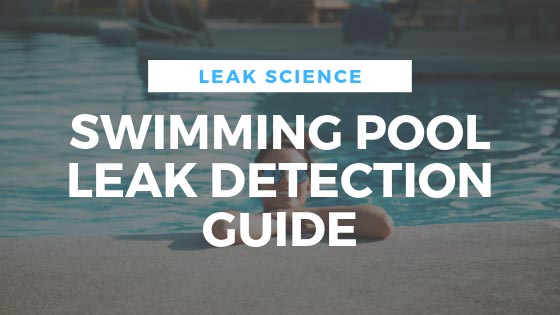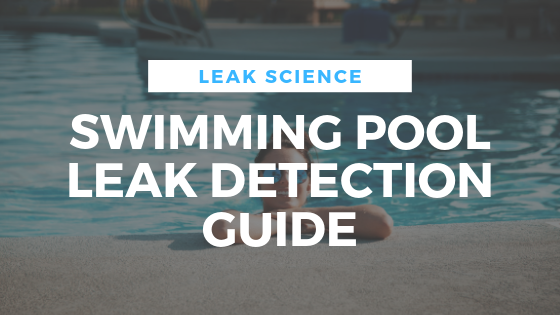
Purchasing a home with a pool, or adding a pool to your home is exciting. You are sure to have a long list of summer and seasonal fun planned, both solo and with friends and family. While fun is certainly at the top of the list, a pool is a commitment. This goes well beyond keeping your pool clean and keeping the pH balanced but to keep an eye out for signs of a leak. Swimming pool leak detection will require you to do more than outsource your pool maintenance, but to learn what risk factors you need to look for as the pool owner in our Swimming Pool Leak Detection Guide.
The True Cost of a Pool Leak
A leaking pool can lead to the need for multiple repairs, and the longer a leak goes unnoticed, the more expensive it will be. From the original repair that caused the leak, increased utilities, the damage to your lawn and pool deck, and maybe even your neighbor’s lawn—a leak can really add up.Connect with an Expert
The Homeowners Swimming Pool Leak Detection Guide
The True Cost of a Pool LeakFinding Leak
Testing for a Leak
Areas Prone to Leaks
Leak Repair
Worried About A Potential Leak?
Leak Science is available to perform a leak inspection for homeowner's pools, commercial pools, and spas.Call now to schedule an inspection at 480-794-0959 or use the form below to get a free estimate.
How much water loss does a pool leak create (typically)?
Your pool will evaporate naturally, which is why it is important to understand the signs of a leaking pool. Most pool leaks start out small and gradually increase if gone undetected. There are many reasons a leak can start, but the average leak starts off fairly small. A general rule of thumb is that if you lose more than 1/4 of an inch of water each day, then there is likely a leak. This would total of 1.5 inches of water loss each week, which would be on the high side of the spectrum. While 1/4 of an inch indicates a leak, 1/8 is considered average evaporation. Such a small fraction of water loss is hard to eyeball, so you must learn how to determine if a leak has occurred. Related Topic: How To Find A Leak In A Pool
How much does a water leak cost (increases in electric/water bill)?
A pool leak can lead to a long list of leak-related expenses and repairs. However, one sign that a leak has occurred is that you see a spike in your water or electric bill. This spike could indicate the need for a repair elsewhere in your home, but your pool should be high on the list of areas to check. The spike will be noticeable and well above the general spike you see during pool season.A pinhole leak can waste as much as 970 gallons of water per day, which is about 4 times the water a family of four consumes each day.
Your spike in electricity will vary greatly depending on the size of your pool, and how many solar components you use. A leak often causes your pump, filter, and filler to work overtime, meaning your energy consumption could easily double your monthly energy bill.

Swimming Pool Leak Detection
Energy and water prices vary greatly around the nation, but one thing is for sure—a leaking pool can lead to a multitude of expenses. This means you must know the most common signs of a leak.
Look for the signs of a leak
Many areas of your pool can leak, so you must get familiar with your pool’s general parts. If you have pool maintenance performed weekly, your service company will also look for signs of a leak. However, you must know what to look for yourself, because some are easy to justify—and many leaks are out of sight.
> Losing more water than regular evaporation
Between the weather, pool use, and splashing while at play—water loss can be difficult to identify. However, water loss beyond standard evaporation is one of the most common signs of a leak.
> Air in the system
If you see air bubbles coming out of the return lines in your pool, you likely have a leak somewhere in the filtration system.
> Visible cracks
Visible cracks often begin as a small pinhole or a crack that is so small it would be difficult to identify. By the time a crack is visible, there is almost always a leak.
> Pool deck sinking or lifting
Leaks that occur underground can lead to pooling water that can damage your pool deck. Any damage should not be written off as a sign of wear and tear, but instead as a possible sign of a leak.
> Soggy spots around the pool
It is easy to think that a soggy spot or two in your yard is due to rain or overwatering, but it could also be this sign of a leak.
> You’re adding water frequently
If you have had to increase the frequency in which you fill your pool, or your auto-filler is running constantly, it is likely in response to a leak.
> Inconsistent pH
If you are having a difficult time keeping your pH balanced, then it could also be a sign of a leak.
Testing For A Leak
If you suspect a leak, there are a couple of fast and easy DIY ways to confirm. Some tests below are simple, while others are a bit more complex.
Dye Test
A dye test is best to use if you see a tear in your liner or a visible crack in your pool. Dye tests can be found at your local pool or home and garden store. You can also use a dye test to test areas such as screws, fittings, skimmers, or any other area at a higher risk of a leak. Have everyone exit the pool, turn off the pool equipment, and wait until the water is calm. Then slowly apply a small yet visible amount of dye directly to the suspected area. What you are looking to see is if the dye remains and gradually dissipates—or if it is sucked into the suspected area.
Bucket Test
All you need for a bucket test is a clean empty bucket, a heavy rock or brick, and duct tape. You will need to perform the bucket test when it is not raining, and when the pool will not be used for 24 hours. If possible, select a day that is not particularly humid. The video below walks you through the bucket test:Another option is to have a water marker installed in your pool.
Pressure Test
A pressure test is more complex, but you can do it yourself with the proper tools. This video will walk you through a pressure test.Areas Prone to Leaks
Some areas of your pool are more prone to leaks than others. Learn where these areas are, so you can keep an eye on them.Liner
Every pool liner has a different lifespan. At the low end, a liner can last 8 years, and 20 years on the high end. Pool use, weather, and ongoing maintenance play a role in how long your liner will last, meaning even if a pool liner is within its suggested life span, it could fail.Filter
If you determine that your filter is the source of your leak, then immediate cleaning, repair, or replacement is required. Filters need regular cleaning and maintenance, some of which you can learn to do yourself.Pump
If your pool pump has failed, it can lead to a costly and damaging leak. If caught early enough, you may repair your current pump, but if left too long, you may have to replace the pump entirely. If you have yet to invest in an energy-efficient pump, this is the perfect opportunity to do so.> Do leaks happen more with or without the pump on?
Pool leaks can occur when the pump is running, or when the pump is turned off. When your pump leaks (on or off) helps you to determine which part of the pump is faulty—either the pressure side or the suction side.
> Pressure side plumbing leak
There are several indicators you might have a leak in the pressure side, some of the most common include:
Cloudy water
Floating skimmer baskets
Air bubble or air in the strainer
The pool needs more frequent vacuuming
Flow rate is low
The pump is not working when turned on or is struggling to work
> Suction side plumbing leak
Some signs that a suction side plumbing leak has occurred include:
Dripping, leaking or spraying water at the connection site to form the pipe to pump
Pooling water on or around the pump
Rapid water loss
Signs of water damage to pool deck or yard
Leak Repair
Many things can go wrong with your filter, one of which is a leaking filter. Filter leaks are often easy to identify, because either a hole, crack, or pooling water will be visible.
What options are available for leak repair?
Sometimes, cleaning or replacing the O-ring is all you need to do to address the leak. However, if there are any visible holes or cracks, the entire filter must be replaced. If you notice a visible hole or crack, feel free to patch it while waiting for professional repair. Just remember that a patch is a very temporary solution and that you cannot put off a full replacement.
Why choose a professional leak detector?
Your sand filter might look fairly basic but has many components, meaning that professional repair is the best way to ensure that they are all working together properly—and that the appropriate course of repair or replacement is selected. Patching a leaky area is not an option because the patch will not hold for long. This swimming pool leak detection guide empowers homeowners to take an active role in maintaining their pool and to provide the invaluable skills required to determine if you have a leak.Connect with an Expert
We Asked Leak Detection Experts for Their Number One Tip for Homeowners Facing a Possible Leak
Here's what the experts had to say.Look for air in the return flow. The presence of lots of small bubbles means the leak is in a suction line. No bubbles usually mean the leak is elsewhere. Narrowing down the possibilities can be helpful.
Alan // Ask Alan A Question
We are like detectives, so the more reliable info the customer can provide us the better. Water loss in inches per day. Make sure your backwash valve is not leaking. Please let us know of anything out of the ordinary, for example, the air in the system. Please make sure your pool is clean and clear and full of water on leak detection day. WE MUST have those items done in order to fully check your pool.
Keith // All Pro Leak Detection
If you believe you have a leak in your pool or spa, there is a simple 24-hour test that you can do to determine whether there is indeed a leak, and what amount of water is being lost. This test is called "The Bucket Test".
Matti // Find It Leak Repair
